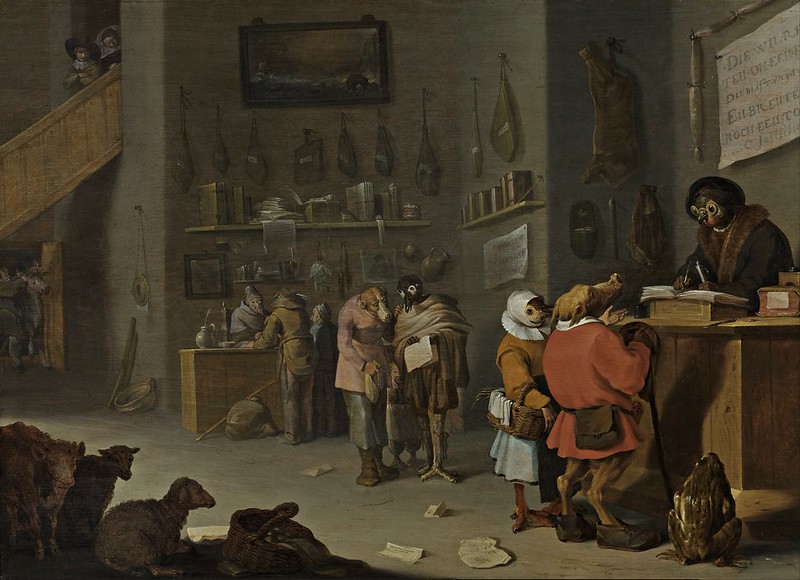Parlem de Pintura...
Cornelis Saftleven (Gorcum, 1607 - Rotterdam, 4 de juny de 1681) va ser un pintor barroc holandès, especialitzat en paisatges i en pintures de gènere. Nascut a Gorcum, es va haver d'establir aviat a Rotterdam amb el seu pare, també pintor, amb qui probablement es va iniciar en la pintura. El 1632 se'l documenta a Rotterdam i poc després a Anvers on va entrar en contacte amb Rubens, autor d'algunes de les figures dels seus quadres. A la mort d'aquest el 1640, es van inventariar entre els seus béns vuit pintures de Saftleven, quatre d'elles amb figures del mateix Rubens. La influència del mestre flamenc en l'obra de Saftleven, amb tot, és mínima ja que no es coneix cap pintura rellevant fruit de la seva col·laboració. El 1637, després d'una curta estada a Utrecht on residia el seu germà Herman Saftleven (1609-1685), amb qui va col·laborar en algun retrat, va retornar a Rotterdam on el 1667 va ser designat degà del gremi local de pintors. Tot i que el gruix de la seva producció el formen els paisatges amb figures i les pintures de gènere, amb nombroses escenes camperoles i de tavernes a la manera de David Teniers el Jove i d'Adriaen Brouwer, va pintar també quadres històrics amb motius religiosos i mitològics i algun retrat amb un elevat nombre d'estudis d'animals utilitzats en les seves pintures d'estables i d'interiors, gènere nou en la pintura holandesa de la que els germans Saftleven han de ser considerats els precursors. Va morir a Rotterdam el juny de 1681.
Font: En català: No disponible - En castellano: Cornelis Saftleven (1607-1681) - In english: Cornelis Saftleven (1607-1681) - Altres: Cornelis Saftleven (1607-1681)
Parlem de Música...
Ignazio Sieber (c.1680 - Venècia?, c.1757) va ser un flautista, oboista i compositor italià. Es desconeix la quasi totalitat de la seva vida. Es creu que va viure a Alemanya abans de publicar les seves Sonates per a Flauta a Roma a l'entorn del 1722. Va viure a Venècia, ciutat on va treballar com a professor de flauta i oboè a l'Ospedale della Pietà a partir del 1728 i on es creu que va col·laborar amb Vivaldi. Per tant, és probable que morís en aquella ciutat a l'entorn del 1757.
Parlem amb veu pròpia... (vacances)
Certainly more interesting and demanding than the Galliard sonatas that precede them, Sieber’s sonatas are in C major (two), a minor, and g minor (three!), all key choices which echo Händel’s opus 1 recorder sonatas (also thought to have been written in Italy). The music is well written for the instrument, lies comfortably, it’s reasonably challenging, and he has a witty way with passagework. The slow movements include some examples of notated ornamentation but there’s much additional scope for a player to experiment with phrasing, articulation, pacing, and further elaboration. The continuo parts similarly offer a lot of opportunity for creative experimentation. As with many lesser-known Baroque sonatas, the writing isn’t dazzling or brilliant throughout but then, let’s admit it, neither is Vivaldi’s. Plus, Sieber’s music provides considerable opportunity to add your own thoughtful two-cents-worth well beyond a few ornaments. You can team up with him to create something extra, an interpretation which you might call even more ‘your own’ than your versions of Telemann or Vivaldi. I’ve heard similarly unfamiliar pieces dismissed as not worth working on, but I wonder if such judgement is passed either because the recorder part has too few fast sixteenth note passages, and/or because the player lacks imagination. As we all know the components of a good piece and a good performance are many and varied; and if you do really want more fast arpeggios, you can almost always add some…
Plus, if you’re looking to create a program of music from a certain city or region, in a certain style or by a particular group of composers, having repertoire like this is a real boon.
Ignazio Sieber’s Recorder Sonatas (calliopessister.com)
Gaudiu i compartiu!
Informació addicional...
PRESTOCLASSICAL: Sieber, I: Recorder Sonatas Nos. 1 - 6
CPDL: No disponible
SPOTIFY: No disponible


Un administrador del blog ha eliminat aquest comentari.
ResponElimina